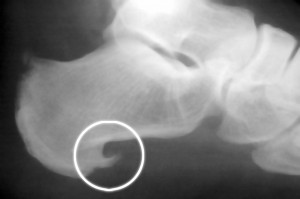Testimonials
REVIEWS OF DR. SCHULER
Foot Doctor Podiatrist, Explains Heel Spur Syndrome
|
HEEL SPUR IN THE CIRCLE Dr. Burton S. Schuler a Foot Doctor, Podiatrist, of Panama City Beach, Panama City, Fl. Explains Heel Spur Syndrome . In it Schuler cites the Mayo Clinic website that says a bone spur of the heel s bony projections that develop along the edges of bones, rubbing against nearby nerves and bones, causing pain. They usually form where bones meet each other — in your joints. Dr Schuler also says they can also be found where ligaments and tendons connect with bone. Most bone spurs cause no symptoms and may go undetected for years. What treatment, if any, that you receive for your bone spurs depends on where they’re located and how they affect your health . again in citing mayo’s http://www.mayoclinic.com/health/bone-spurs/DS00627also). Many readers have probably heard of heel spurs, but they are not exactly sure what one is. The foot’s largest bone is the heel bone, and therefore it absorbs the most shock and pressure. The plantar fascia is a band of fibrous tissue on the bottom of the foot, running the entire expanse of the foot. A heel spur is an abnormal growth on the heel bone; when the plantar fascia pulls away from the heel, calcium deposits form, causing heel spurs. This can be an extremely painful condition, impairing your ability to walk In order to avoid a heel spur, one need to avoid having the plantar fascia pull away from the heel. Dr. Burton S. Schuler, podiatrist of Panama City Fl” is correct in stating that “…the stretching of the plantar fascia is usually the result of over-pronation. ww w. Footcare4u.com But then we must ask, what causes over-pronation? Dr. Dudley J. Morton, one of the leading researchers on feet in the twentieth century, warned about how a short first metatarsal bone (“Morton’s Toe”) (Long Second Toe) can cause over-pronation of the foot. Dr . . . . Schuler, explains: “If you have a Morton’s Toe the front part of the foot is unstable when it needs to be stable. Because of this, the foot will be forced to pronate. A pronating foot places abnormal stress on many areas of the foot, including the plantar fascia and the heel bone. It is this abnormal stress that is the start of all the heel problems noted above” (http: www.whyyouhurt.com). If a longer second toe is causing your painful heel problems, do not despair. The toe-pad that Schuler prescribes for Morton’s Toe (placed under the first toe of an over-pronating foot) can help heal those painful heels—as it already has in many cases. Dr. Burton S. Schuler is a foot doctor, foot specialist (Podiatrist), of Panama City, Fl and the director of the Ambulatory Foot Clinics Podiatric Pain Management Center. He is also the author of the new book Why You Really Hurt: It All Starts In The Foot |

